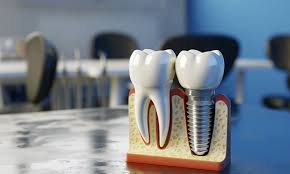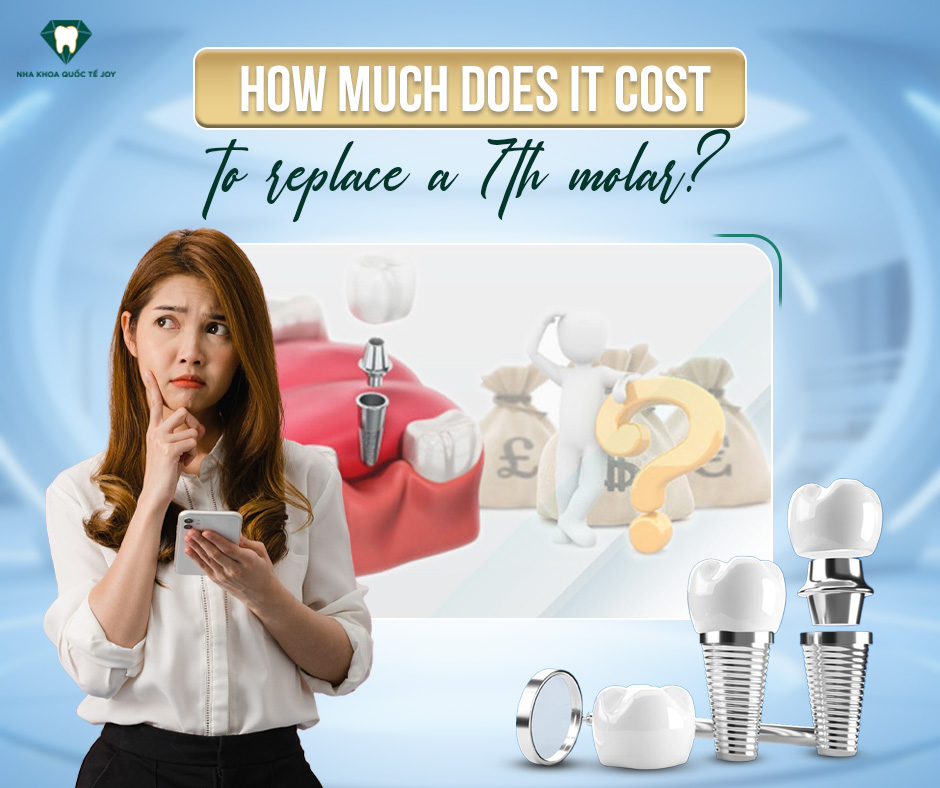The 7th molar, also known as the second molar, plays a vital role in the chewing process. Its loss necessitates prompt and appropriate restoration. However, The cost of replace a 7th molar is a major concern for many. Joy International Dental Clinic addresses this concern in the following article.
1. The Crucial Role of the 7th Molar
The 7th molar is an indispensable component of our dentition. Its large size and robust structure equip it for the crucial task of chewing and grinding food before it enters the stomach. Situated deep within the jaw, it effectively distributes chewing pressure among other teeth, contributing to overall jaw balance and stability. Though often overlooked, the presence of the 7th molar is foundational for a healthy digestive system and a complete set of teeth. Losing this tooth can severely impact eating habits and overall well-being.

2. The Dangers of Losing a 7th Molar
As mentioned, the 7th molar is essential for maintaining stability and force distribution across the dental arch. Consequently, losing it can lead to several adverse conditions:
- Digestive Problems: Reduced chewing efficiency means food is not adequately broken down before entering the stomach. This puts extra strain on the digestive system, potentially leading to issues like stomachaches, gastritis, and colitis. The larger food particles are harder for the stomach to process, impacting nutrient absorption and overall digestive health.
- Shifting of Adjacent Teeth: The absence of the 7th molar disrupts the natural alignment of the dental arch. Neighboring teeth may drift or tilt into the empty space, causing malocclusion (misalignment of the bite) and making cleaning more difficult. This can increase the risk of tooth decay and gum disease in the affected area.
- Facial Structure Changes: Prolonged tooth loss leads to bone resorption (deterioration of the jawbone). This can cause the cheeks to appear sunken, giving the face a prematurely aged appearance. The skin around the mouth may also sag and develop more wrinkles. This bone loss not only affects aesthetics but also complicates future restorative procedures like dental implants.
- Increased Risk of Gum Disease: The gap left by the missing tooth creates a trap for food particles and bacteria, making it difficult to maintain proper oral hygiene. This increases the risk of gingivitis (gum inflammation) and periodontitis (advanced gum disease), which can further damage the supporting structures of the teeth and even lead to further tooth loss.
- Temporomandibular Joint (TMJ) Disorders: The imbalance caused by missing teeth can put stress on the temporomandibular joint, which connects the jaw to the skull. This can lead to TMJ disorders, characterized by jaw pain, clicking or popping sounds in the jaw joint, headaches, and difficulty opening or closing the mouth.

3. When is 7th Molar Extraction Necessary?
Despite its importance, extraction of the 7th molar is sometimes unavoidable to protect overall oral health. Common reasons include:
- Severe Tooth Decay: If decay has progressed to the point where it has significantly damaged the tooth structure, affecting the pulp (nerve) and making restoration impossible, extraction becomes necessary to prevent further infection and pain.
- Untreatable Pulpitis: When the dental pulp becomes inflamed or infected and root canal therapy is not feasible, extraction is the only option to eliminate the source of infection.
- Tooth Fracture: If the tooth is fractured extensively, especially below the gum line, it may not be salvageable and will need to be extracted.
- Severe Periodontal Disease: Advanced gum disease that has destroyed the supporting bone structure around the tooth may necessitate extraction to prevent the spread of infection to other teeth and the surrounding bone.
- Impacted Teeth: If the 7th molar is impacted (unable to erupt fully), it can cause pain, infection, and damage to adjacent teeth, making extraction necessary.
4. Restoration Options for Missing 7th Molars
Two primary methods are used to replace missing 7th molars:
4.1. Dental Bridges:
A dental bridge is a fixed prosthetic appliance that replaces one or more missing teeth by anchoring artificial teeth (pontics) to adjacent natural teeth (abutment teeth).
- Procedure: The abutment teeth are prepared by reshaping them to accommodate crowns that will serve as anchors for the bridge. An impression is taken, and a custom-made bridge is fabricated in a dental laboratory. The bridge is then cemented onto the prepared teeth.
- Advantages: Relatively quick procedure, more affordable than implants.
- Disadvantages: Requires altering healthy adjacent teeth, does not prevent bone loss, has a shorter lifespan compared to implants (typically 5-10 years).

4.2. Dental Implants:
Dental implants are considered the gold standard for tooth replacement. They involve surgically placing a titanium post (implant) into the jawbone to act as an artificial tooth root.
- Procedure: The implant is surgically placed into the jawbone. After a period of healing (osseointegration), during which the implant fuses with the bone, an abutment (connector) is attached to the implant. Finally, a custom-made crown is attached to the abutment.
- Advantages: Replaces both the tooth and its root, prevents bone loss, provides excellent stability and chewing function, has a long lifespan (often lasting decades with proper care), does not affect adjacent teeth.
- Disadvantages: More expensive than bridges, requires a surgical procedure, longer treatment time due to the healing period.

5. The cost of replace a 7th molar?
The cost of replacing a 7th molar varies depending on the chosen method, the materials used, and the dental clinic.
5.1. The cost of repalce a 7th molar with Dental Bridges:
The cost of a dental bridge typically ranges from 4.5 million to 24 million VND, depending on the material of the crowns (metal-fused-to-porcelain, all-ceramic, or high-end porcelain).
5.2. The cost of repalce a 7th molar with Dental Implants:
The cost of a dental implant typically ranges from 15 million to 40 million VND per tooth. This includes the cost of the implant, abutment, and crown. The price can vary based on the implant brand (e.g., Korean, American, European), the type of crown, and any additional procedures required (e.g., bone grafting).
Conclusion
The cost of replacing a 7th molar depends on the chosen treatment method and individual circumstances. To ensure optimal results and manage costs effectively, it is crucial to choose a reputable dental clinic like Joy International Dental Clinic. With experienced dentists and advanced technology, Joy is committed to providing safe, high-quality tooth replacement experiences, helping patients maintain healthy and confident smiles. Contact Joy International Dental Clinic for a detailed consultation and personalized treatment plan.






